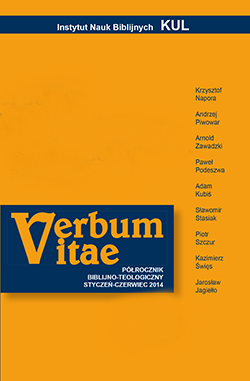Janowe rozumienie pracy Boga i człowieka. Studium zastosowania terminów ergazomai oraz ergon w czwartej Ewangelii
The Johannine Understanding of Divine and Human Work: The Use of the Lexemes ergazomai and ergon in the Fourth Gospel
Author(s): Adam KubiśSubject(s): Christian Theology and Religion
Published by: Katolicki Uniwersytet Lubelski Jana Pawła II - Wydział Teologii
Keywords: work; ergazomai; ergon; Gospel of John
Summary/Abstract: The article deals with the concept of work as reflected in the Fourth Gospel, encompassing the two cognate lexemes evrga,zomai and e;rgon. The analysis is organized according to the subjects who are performing a given work, to wit: the Father, the Son, Jesus’ disciples (including Abraham) and, finally, the people hostile toward God, designated in the Gospel by the general term world. Interestingly enough, both of the studied lexemes appear in John’s Gospel only on the lips of Jesus. Additionally, as it turns out, the Johannine concept of work covers a whole range of meanings: the activity of the Father and the Son (who give life and perform judgment), the salvific mission of the Son, Jesus’ teaching and his obedience to the Father’swill, miraculous healings, human deeds in general (both good or bad), disciples’ fulfillment of God’s will, meaning primarily their faith in Jesus as the Messiah and the Son of God. In a nutshell, the very essence of the work of the Father and the Son (and continued by Jesus’ disciples) can be encapsulated in the concept of salvation.
Journal: Verbum Vitae
- Issue Year: 2014
- Issue No: 25
- Page Range: 127-154
- Page Count: 28

